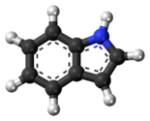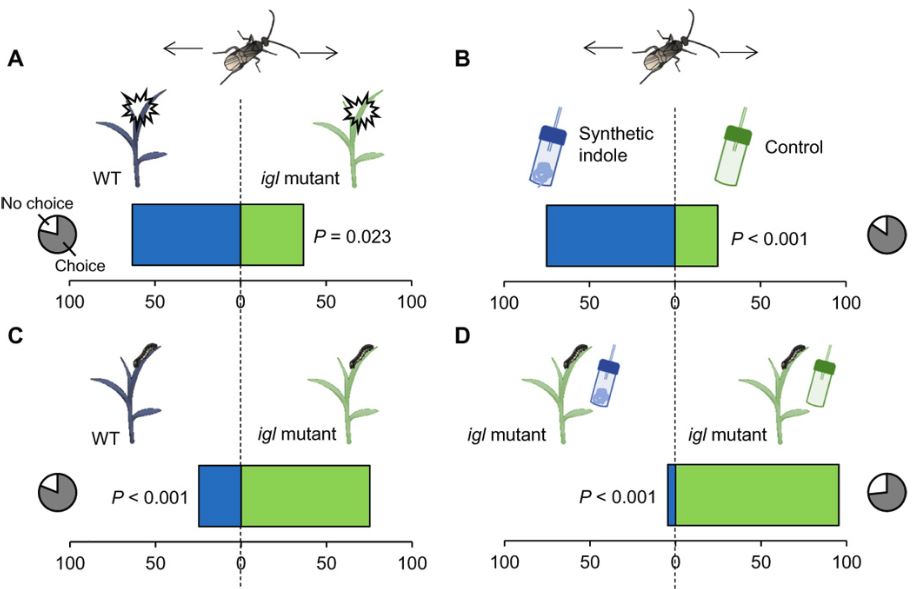
In nature, insect herbivores eat plants and other insects parasitize the herbivore insects, creating a tritrophic system. Ye and colleagues investigated how volatile chemicals (odorant molecules) affect one such tritrophic system—corn herbivory by moth larvae (caterpillars) of Spodoptera littoralis and the parasitism of the caterpillars by the wasp Microplitis rufiventris (Figure 1). The moth lays eggs on the leaves of the plant. When the eggs hatch, the caterpillars eat the plant. The female wasp injects an egg into the caterpillar and, after hatching, the wasp larva feeds on the moth larva.

Plants are not completely defenseless against the moth larvae, and the moth larvae are not completely defenseless against the wasps. Plants release volatile chemicals as part of their defense against herbivores. These chemicals are referred to as herbivore-induced plant volatiles (HIPVs). Indole is an HIPV (Figure 2) produced in response to molecules in the caterpillar oral secretions (spit) and plant damage. Production of indole requires the enzyme indole-3-glycerol phosphate lyase (IGL). The authors used indole as a chemical or wild-type and Igl-deficient maize plants to determine how this HIPV affected the tritrophic interactions between the plant, the moth larvae, and the female wasps.
Female wasps were placed in an olfactometer, a device that delivered different odors into chambers, and their movement toward different plants with and without the moth larvae was recorded. The wasps preferred wild-type plants (indole-positive) subjected to injury and oral secretions from the caterpillars over Igl-mutant plants (indole-negative) subjected to oral secretions from the caterpillars. Surprisingly, the wasps preferred the Igl-mutant plants when the caterpillars were present. The wasps moved to the chamber with the Igl-mutant plants with the caterpillars rather than the chamber with Igl-mutant plants with caterpillars and an indole dispenser. Thus, indole itself was not repelling the wasps. Indole was changing something about the plants with the caterpillars or the caterpillars themselves. Using the olfactometer, the authors gave the wasps a choice between caterpillars that had eaten wild-type or Igl-mutant plants or caterpillars exposed to indole. The wasps preferred the caterpillars that had eaten the Igl-mutant plants. Thus, indole changed the attractiveness of the caterpillars to the female wasps.
Although indole triggered some death of the caterpillars (10%), which would provide some advantage to the plant in the absence of the wasps, indole provided a clear survival advantage to the caterpillars when the wasps were present. More than 60% of the caterpillars died in the presence of the wasps. If the caterpillars had eaten wild-type corn plants or been exposed to indole, then less than 40% of them were killed by the wasps. Unexpectedly, the wasps attacked the caterpillars regardless of whether they had eaten wild-type or Igl-mutant plants. The survival benefit for the caterpillars related to impaired success in parasitization, either through decreased delivery of the wasp egg or survival of the wasp egg in caterpillars exposed to indole or fed wild-type corn.
In yet another plot twist, the caterpillars avoided moving toward an indole dispenser, but only if they had not been previously exposed to wasps. Just 30 minutes in the presence of the parasitic wasp without any contact was enough to eliminate the avoidance of indole by the caterpillars. Thus, the caterpillars respond to odors produced by the wasps and this changes their response to indole. The caterpillars change their odor and reduce their effectiveness as a host for the wasp eggs in response to exposure to indole. The wasps detect this change in the caterpillars that have been exposed to indole and, if provided a choice, will inject their eggs into caterpillars that have not undergone this indole-dependent change.
Highlighted Article
M. Ye, N. Veyrat, H. Xu, L. Fu, T. C. J. Turlings, M. Erb, An herbivore-induced plant volatile reduces parasitoid attraction by chaning the smell of caterpillars. Sci. Adv. 4, eaar4767 (2018). Online Journal
Cite as: N. R. Gough, Odor Battles: From Corn to Caterpillar to Wasp. BioSerendipity (23 May 2018) https://www.bioserendipity.com/plant-insect-tritrophism/.

